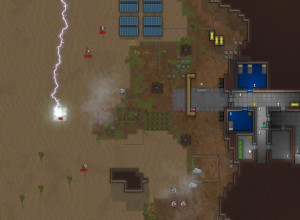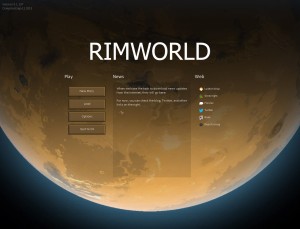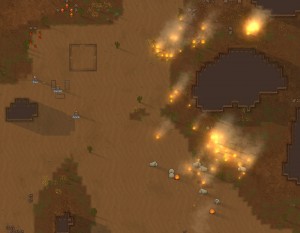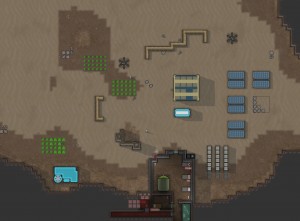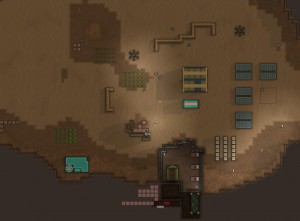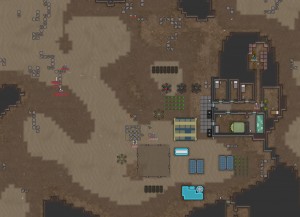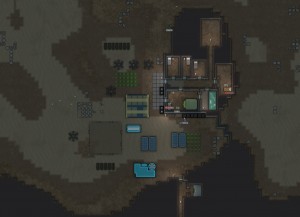Well, now you know it’s a real game. User BRTD_Y just put up a subreddit for discussions on RimWorld.
RimWorld subreddit
Seeking Artist
I could use some help on the art for RimWorld. If you are a 2D artist, or you know one who you think could do good work on this game, please email me at [email protected]
First Look Video Released!
Yesterday I put out our first look video of RimWorld and put it up on a nice little landing page. So now all the stuff we’ve been talking about might start to make a little bit more sense.
This video highlights a few key features.
First, pirate raids. Pirates drop from the sky when the AI storyteller wants, hang around at a random area of the map, then come to get you. The staging delay provides time for the player to go out and pre-emptively attack the pirates, or prepare defenses. In the video, the first pirate is shot and then captured. He’s later recruited; you can see him working for the colony later in the video. Out in the RimWorlds, allegiances are pretty weak – people will tend to join with whatever group or community will offer them some safety and shelter.
The second group of pirates is much larger, but the player has time to buy some weapons from a passing trader before they attack.
Second, look for weather. You’ll see overcast days, thunderstorms with lightning, fog, and overcast days. The weather is, like most other things, controlled by the storyteller. If she wants to make a really dramatic fight, watch her kick up a thunderstorm while the pirates bear down on you. Then she’ll strike one of them with lightning just for fun.
Beyond those two, you can also see the day/night cycle and fires on display, as well as colonist work settings, prisoner treatment settings, and the core building/mining gameplay.
In other news, the video has attracted some attention. There’s a great thread going on the Dwarf Fortress forums where I’ve answered a number of questions about the game. Also, testers are starting discussions in our forums, so there’s more info there if you’d like to look.
Now, a screenshot of a lightning bolt striking a raider. Thanks mother nature!
AI storyteller choices
Here’s just a quick shot of the title screen as it stands. I still need to get an artist to do a real logo treatment for the title. Though straight Tahoma has its charm, I suppose.
I’ve been working on this screen as well as the selection of AI storyteller and starting colonists.
Now you can actually choose your AI storyteller. The starting options are Cassandra Consistent, who tries to keep you on a pre-defined tension curve, Randy Random, who just does crazy stuff, and Phoebe Friendly, who basically makes sure nothing bad happens. Possibilities for expansion are Harry High-Population, who gives you lots of colonists, Negative Nancy, who just starves you, and many others.
The AI storytellers have some new events to play with too: passing travelers, and animal-goes-psychotic. The travelers are cool because you can ignore them, capture them, enslave them, recruit them, or sell them into slavery. Or just kill them and take their stuff (it is still a video game, I suppose). The psychotic animal is more amusing than anything – especially when it’s a squirrel or a boomrat (that is, a weaponized genetically engineered rat that explodes and ignites fires on death).
Starting colonists won’t be created by players any more. The number of options available is becoming too much; it slows down the start of the game to an unacceptable degree. Instead, you’ll just roll up characters until you get one you like. Some of their traits may be hidden, too. Your only direct control over them will be in changing their names.
RimWorld name change
The game previously known as Eclipse Colony is now known as RimWorld. It turned out eclipses weren’t a big part of the game, and the frontier edge-of-civilization thing is.
The muffalo! They burn!
Just a quick post here to show you a fun screenshot. I resurrected the ancient (dating back to when this was a zombie tactics game) fire system, rebalanced and redesigned it, and tightened up the graphics. It turns out that the muffalo, with their shaggy coats, burn rather well! I wonder how much damage a herd of burning muffalo could do to your colonists… or any pirate raiders unfortunate enough to meet them.
Ludeon Studios Inc.
I’m happy to announce that Ludeon Studios is now a federally registered corporation in my home country of Canada! This new ephemeral paperwork status should allow us to actually manage money properly to make deals with contractors and such, avoid some taxes, and learn entirely new kinds of paperwork.
Work on the game continues. Recently I’ve added a whole ecosystem of plants and animals, enhanced various graphical features, and made colonist behaviors even more robust so they’ll sleep and eat outside if needed.
I decided to remove the old breathability system. For a long time, various actions couldn’t be undertaken outdoors because the air wasn’t breathable. This system was a holdover from when the game was called Starship Architect and was basically a mix of Dwarf Fortress and FTL.
The original idea was that being left without air would kill colonists, as it does in FTL. Later, the game was moved to a planet’s surface and became about exploring and going outside to do things. So I weakened the air system so that lacking air merely prevented eating and sleeping and made people unhappy.
Unfortunately, this arrangement proved to be rather annoying. It wasn’t dramatic like vacuum deaths in FTL. It wasn’t interesting to work with or construct. It was mostly just an obstruction and a chore. Players would pressurize their rooms and then forget about them. When a wall was damaged or destroyed, colonists would become unable to sleep in their rooms and players had trouble understanding why. And it created really brutal failure spirals where a colony would be damaged in a fight or something and the lack of pressurization would leave them unable to eat, leading to their insanity or starvation. I’d rather colonies be able to recover from hits and soldier on – the game makes much more interesting stories this way.
I’m working on weather next.
Sun shadows
There are now shadows from the sun in the game. They fade in and out based on time of day, move across the ground, don’t shade indoors, come from people and small objects as well as large structures, project to varying heights, and change color slightly to complement the color of the sky.
This involved creating a whole system for roofing as well – it tracks which areas are roofed, shows you when you create a new roof, and collapses unsupported sections.
It’s always amazing how many times one simple system demands that you model something that seems almost unrelated. The logic of the world is very interconnected; it’s tough to simulate one thing without simulating the things it interacts with.
On the gameplay side, I’ve been working on the power system. So look forward to solar and geothermal plants, power surge and explosions, power cables, battery stacks, and solar flares to shut down your machines.
Rimworld on IndieDB
I’ve created the IndieDB page for Rimworld. Take a look.
Electricity and screenshots
First, some new screenshots from a game I played last night. Raiders attack:
The fight’s aftermath, with raiders buried.
The base:

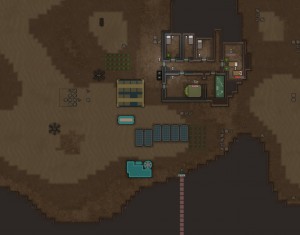 And a pseudo-3D shot of what the game looks like in the editor, just for fun.
And a pseudo-3D shot of what the game looks like in the editor, just for fun.
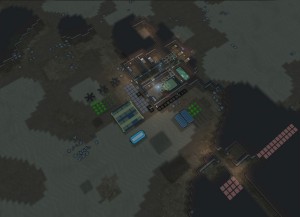
I’ve been working on the electrical system recently. Now, various machines including doors, air generators, gun turrets, lights, and food dispensers require power to work. You can generate power via couple means including solar panels and geothermal plants. But each generation system has downsides – solar panels are large and don’t work at night (requiring power storage), and geothermal requires you to have a plant on top of a geothermal vent, which may be far from your main colony and tough to defend.
Without power, machines don’t work. Lights turn off, doors must be opened and closed manually (which is slow) and food doesn’t dispense.

